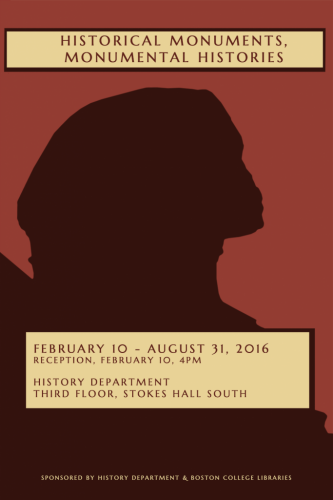It was the sad sight of bare gray walls in the new Stokes Hall that led the department to institute the course “Making History Public” with the idea that a student-curated exhibition would be mounted every semester to adorn the department’s cheerless countenance while simultaneously allowing students to share their research and knowledge with their colleagues, professors, and the wider community. As if killing two birds with one stone was too few birds, the department directed us to BC’s underutilized rare books collection housed at the John J. Burns Library for materials and primary sources to be used in the exhibitions. When I came to teach the course, I chose the theme of “historical monuments.” I had been obsessed with the history of Hagia Sophia in Istanbul/Constantinople, the Umayyad Mosque in Damascus, and the Mezquita in Cordoba. Each of these historical buildings changed not just its function over the centuries, but its very religion. So, it was my fascination with how built structures get assigned different meanings and put to varying uses that led me to teach the course. A librarian at John J. Burns Library was gracious enough to locate relevant materials: travel guidebooks and architectural history surveys. Seven students, a photographer, a couple of librarians, an exhibit specialist, a graphic designer, and a professor worked together. And the rest was (monumental) history.
History Dept, Stokes Hall Exhibit
The History Department in Stokes Hall features exhibits collaborated with the Boston College Libraries for the course HS600 Making History Public. The exhibits change each semester.
Historical Monuments, Monumental Histories
Sponsored by The History Department & The Boston College Libraries
February 10 - August 31, 2016

It was the sad sight of bare gray walls in the new Stokes Hall that led the department to institute the course “Making History Public” with the idea that a student-curated exhibition would be mounted every semester to adorn the department’s cheerless countenance while simultaneously allowing students to share their research and knowledge with their colleagues, professors, and the wider community. As if killing two birds with one stone was too few birds, the department directed us to BC’s underutilized rare books collection housed at the John J. Burns Library for materials and primary sources to be used in the exhibitions. When I came to teach the course, I chose the theme of “historical monuments.” I had been obsessed with the history of Hagia Sophia in Istanbul/Constantinople, the Umayyad Mosque in Damascus, and the Mezquita in Cordoba. Each of these historical buildings changed not just its function over the centuries, but its very religion. So, it was my fascination with how built structures get assigned different meanings and put to varying uses that led me to teach the course. A librarian at John J. Burns Library was gracious enough to locate relevant materials: travel guidebooks and architectural history surveys. Seven students, a photographer, a couple of librarians, an exhibit specialist, a graphic designer, and a professor worked together. And the rest was (monumental) history.

